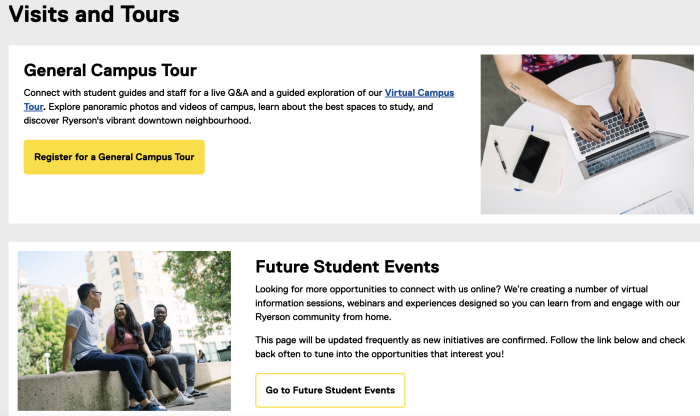Qualified leads are the foundation of any successful business – and this is all the more important for educational institutions. Schools and universities depend on the continual interest and enrollment of new students. With a strong stream of applicants, schools can solidify their standing amidst the growing competition. But to bring in new students each year, you need to first focus on better lead generation for higher education.
Lead generation is about piquing the interest of prospective students through organic or targeted campaigns. As more and more schools invest in their digital presence, applicants have more choices than ever for their academic futures. To capture their attention, your school needs to develop specific strategies to expand its reach on different platforms and tap into new audiences. When you make it easy for visitors to engage with your school, you’re on your way to converting prospects into applicants. Check out some key strategies for generating new leads.
1. Direct Visitors to Your Website With SEO
A website is one of the most important resources for generating new leads. It’s where visitors will learn about your school and develop that initial interest in its values and offerings. But your ability to generate new leads this way largely depends on the number of visitors that reach your website in the first place. In other words, without the proper exposure, your web efforts will go to waste.
A good SEO strategy can help you take the first step in getting your school and its website noticed on search engines. Research shows that the first page of search results enjoys an impressive 95% of all search traffic. At the same time, users are 10x more likely to click on the first organic result than the tenth one. That means the majority of users are not even looking past the first page on Google – and many are only considering the top few results.
SEO practices are your ticket to a top result on search engines and better website traffic. Start by conducting keyword research to determine the phrases that your target audience is using in their searches. You can then reach the right leads for your school by weaving those keywords into your content.
Example: A blog post by the Discovery Community College incorporates the keyword “accounting and finance program” into the title, along with two other relevant keywords in the body of the text. This increases the likelihood of the content being seen by users searching for training in this field.

Source: Discovery Community College
Remember, the content on your website is a reflection of your school, its reputation and its values. So while it’s important to integrate the right keywords, your priority should be delivering high-quality content that appeals to the interests of your prospective students. Perhaps you’re trying to build your image as a research university or boost enrollment for a specific program. In each case, your content should match the unique selling points of your school.
For example, the blogs featured on Digital School’s website explore topics of interest in architecture, engineering and design. The content reflects their authority as a technical design school, along with practical tips to engage prospective students interested in these career paths.

Source: Digital School
Beyond keywords, Google will rank the quality and relevance of your school’s content, so make sure you’re delivering informative pieces on training programs, industry news, student life and more.
Harness the Power of Paid Ads
More and more schools are now relying on paid ads to save time and money in their search engine efforts. Running Pay-Per-Click (PPC) ad campaigns on search engines can be an effective way to grab audience attention and break into crucial markets. Through platforms like Google Ads, schools can pay to have their website appear in the top search results when a relevant keyword is used.
For example, the following schools have invested in paid ads to boost their ranking for the keyword “MBA degree.”

Source: Google
The best part about PPC advertising is that you only pay when a potential lead clicks on your ad. That way, your school invests in a search engine strategy that delivers real results for education lead generation.
Optimize Your Website to Boost Lead Generation for Higher Education
Once you have directed visitors to your website, it’s your job to engage and convert those visitors into leads. For many prospects, your website will be their first impression of your school and its image, so make it count. When building your website, the primary focus should be on user experience. Is your site clear and easy to navigate? Is it informative for prospects and their families? Does it deliver a strong sense of your school’s image and branding? The easier you make it for visitors to learn about your school, the closer they come to connecting with it as a qualified lead.
Example: Cumberland College’s landing page answers the most common question: Why study here? The website is also user-friendly by providing options for prospective students to choose from when learning about the college:

Source: Cumberland College
Connect With Prospects Through Chat Features
Building a lead nurturing environment is about encouraging visitors to engage with your website and its content. Interactive features are a great way to drive this kind of activity.
When researching schools and visiting their websites, prospective students will have questions regarding everything from specific programs they’re interested in, to financial aid options. Ideally, your school’s website should answer prospects’ most common questions. However, many applicants prefer to get clarification from an expert at your school or learn more about their situation.
Example: Randolph-Macon Academy is committed to assisting families through the financial aid application process. Admissions counselors are equipped to advocate for scholarships on the student’s behalf, ensuring their application is accurately completed. They also provide payment plan options.

Source: R-MA
Live chat features give visitors an easy way to connect with an admissions representative directly and get the answers they need. While giving prospects another avenue to learn more about the specific offerings at your school, chat features elevate the user experience to a more personal level.
For example, Washington State University allows visitors to see which admissions reps are online and can chat through their website.

Source: Washington State University
Of course, it can be difficult to respond to every query that comes your way, since 24/7 support is challenging and costly. If you want to take a load off, consider chatbots programmed to provide automated responses to visitor questions. Having a responsive system will do much more for the image of professionalism and credibility surrounding your school.
At a minimum, your website should highlight the contact details for relevant admissions departments – such as those for international students and financial aid – to satisfy any curiosity in your school.
Design Landing Pages to Convert Visitors into Leads
Landing pages are essential forms for capturing leads. They are where prospects will register their interest in your school and take the first step in becoming qualified leads. Your landing pages should be informative, eye-catching and action-oriented. Their purpose should be clear and prospects should find it easy to register their interests. A well-designed landing page should convince users to take the next step in the student recruitment funnel.
Example: This landing page from the Toronto Metropolitan University captures leads by informing them of upcoming campus visits and tours. The page features clear Call-to-Action buttons that lead visitors to register for the events.

Source: Toronto Metropolitan University
Remember, you’re trying to direct visitors to a single destination with persuasive messaging. With that purpose in mind, the content should be informative and concise; resist the temptation to crowd landing pages with unnecessary text and links.
2. Host Community Events to Improve Lead Generation for Higher Education
A suggestive answer to how do you get leads for school? Open days and other campus events carry a lot of weight in an applicant’s decision to attend a school. These are when your school – its community, programs, and faculty – truly come to life in the minds of prospective students.
Regarding lead generation for universities, in-person events are extremely valuable in engaging prospects at different stages of their journey. They not only help to secure applicants in the decision stage, but they also help to build awareness of your school and nurture interest in the early stages. Those just learning about your school may hear of upcoming visits and be compelled to take the next step in connecting with your school.
Virtual events are a good alternative to generate leads from an even wider pool of prospects. Today, more and more applicants are drawn to the chance to tour campuses and hear from students and faculty from their homes. While in-person events are crucial, the convenience that virtual events afford both schools and their target audiences is unmatched.
Example: The University of Bristol has a page on its website dedicated to virtual events. Prospects can take a self-guided tour of the campus and even the surrounding city.

Source: University of Bristol
Virtual events also make it easier to generate leads by directing visitors to landing pages on the same website. Your school can more effectively manage lead generation with all the relevant information on one platform.
Another way to enhance education leads is by having student testimonials available for prospective students to learn about the institute from a fellow student.
Example: Automotive Training Centres provides a link to their student testimonials:

Source: ATC Montreal
3. Create Email Campaigns for Education Lead Generation
Effective lead generation doesn’t end with initiating interest; you have to nurture that interest with the goal of converting prospects into applicants. With the global e-mail marketing market projected to reach $17.9 billion by 2027, email is an essential tool for generating and nurturing leads.
Email campaigns allow you to deliver consistent, personalized messages to prospects who have indicated an interest in your school. As you generate leads, it’s important to track them and monitor where they are in their journey. Marketing automation software allows you to organize leads about their academic or social interests and initiate an email sequence that will funnel them into applicants. Emails may include content on upcoming open houses, program requirements, financial aid applications, extracurricular offerings and more.
Example: This email from McMaster University is sent to prospects who have registered an interest in studying in the Faculty of Engineering. The email guides recipients through the different program options and leads them to take the next step in decision making.

Source: McMaster University
4. Get Creative on Social Media Platforms
Generating leads for your school involves engaging prospective students where they are most active. Millennials and Gen Z make up many target audiences for schools, including universities and career colleges worldwide.
According to the World Economic Forum, millennials are logged on to social media for an average of two hours and 38 minutes daily, while Gen Z logs on for two hours and 55 minutes. If you’re wondering how to generate student leads from these audiences, social media is the answer.
Your school should maintain an active presence across social media platforms, posting content frequently and engaging with users who comment or ask questions on your accounts. While schools have long used Facebook, Twitter, and LinkedIn to market their programs to young professionals, schools are now extending their presence on more creative platforms like TikTok to reach younger audiences.
The snappy video format of TikTok is perfect for schools looking to pique the interest of leads in just 15 seconds. To generate leads this way, content should aim to take an authentic sneak peek at your school, its programs, student culture, and campus community.
For example, a TikTok by Cambridge University follows one of its students as part of a “Day in the Life” series. This is a fun and personalized way for leads to connect with the student community at Cambridge.

Source: TikTok
If you want to generate more leads for a specific area of study, consider posting content that positions your school as an authority on the topic.
For example, Cumberland College posted a video on Instagram where one of its instructors discusses the value of digital marketing training today. As a school specializing in digital marketing programs, this post helps generate qualified leads by showcasing its expertise in the industry.

Source: Instagram
Other ideas to consider for social media posts are alumni stories, university campaigns, campus tours, and faculty introductions. Whatever you choose to focus on, take advantage of social media’s fun and dynamic features to connect with student leads on their own grounds.
Researching and deciding on a school can be a lengthy and frustrating for prospects. By meeting prospective students where they are and making it easy for them to take the next step in connecting with your school, you can secure a steady stream of applicants from qualified leads and generally improve your lead generation for higher education efforts.







